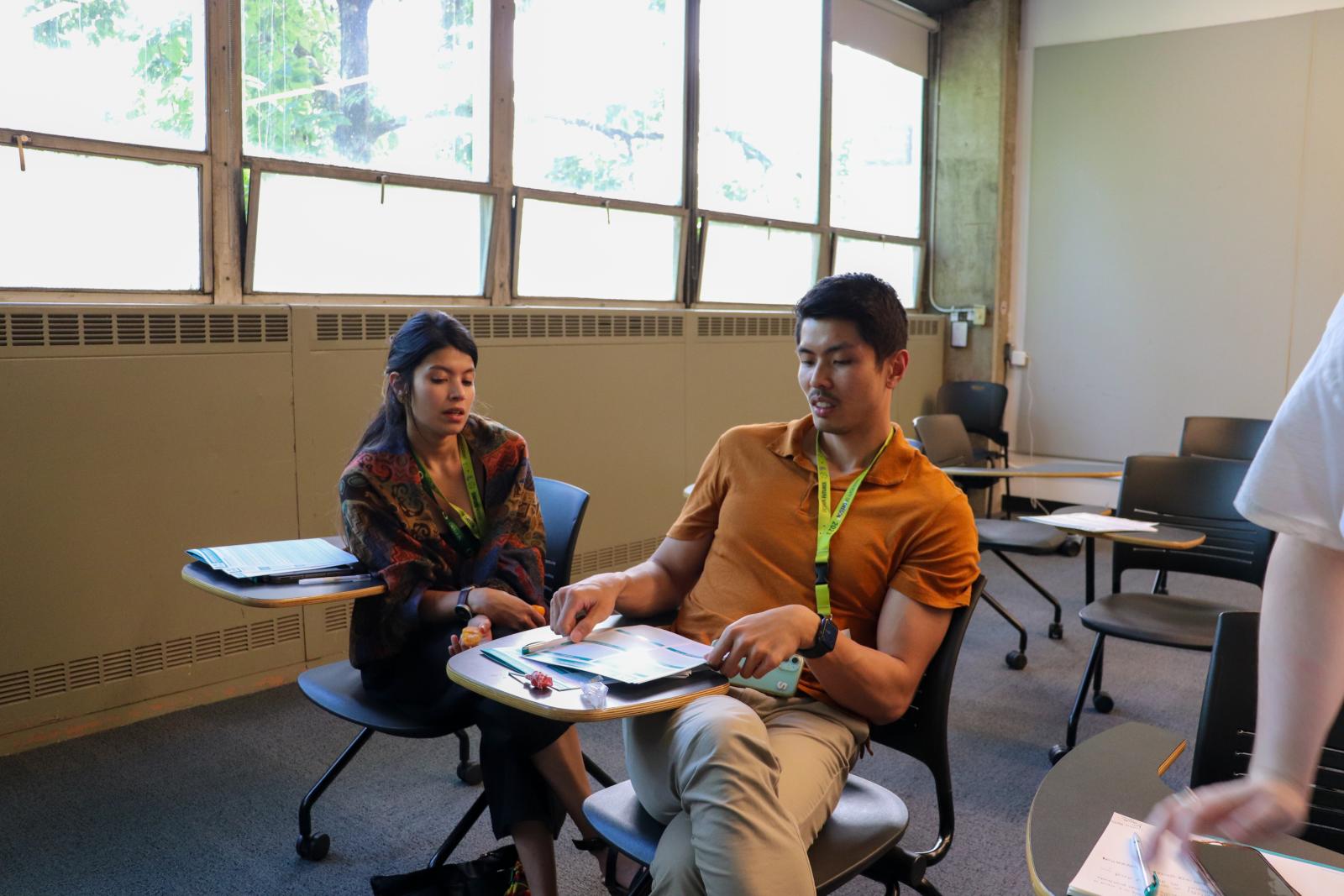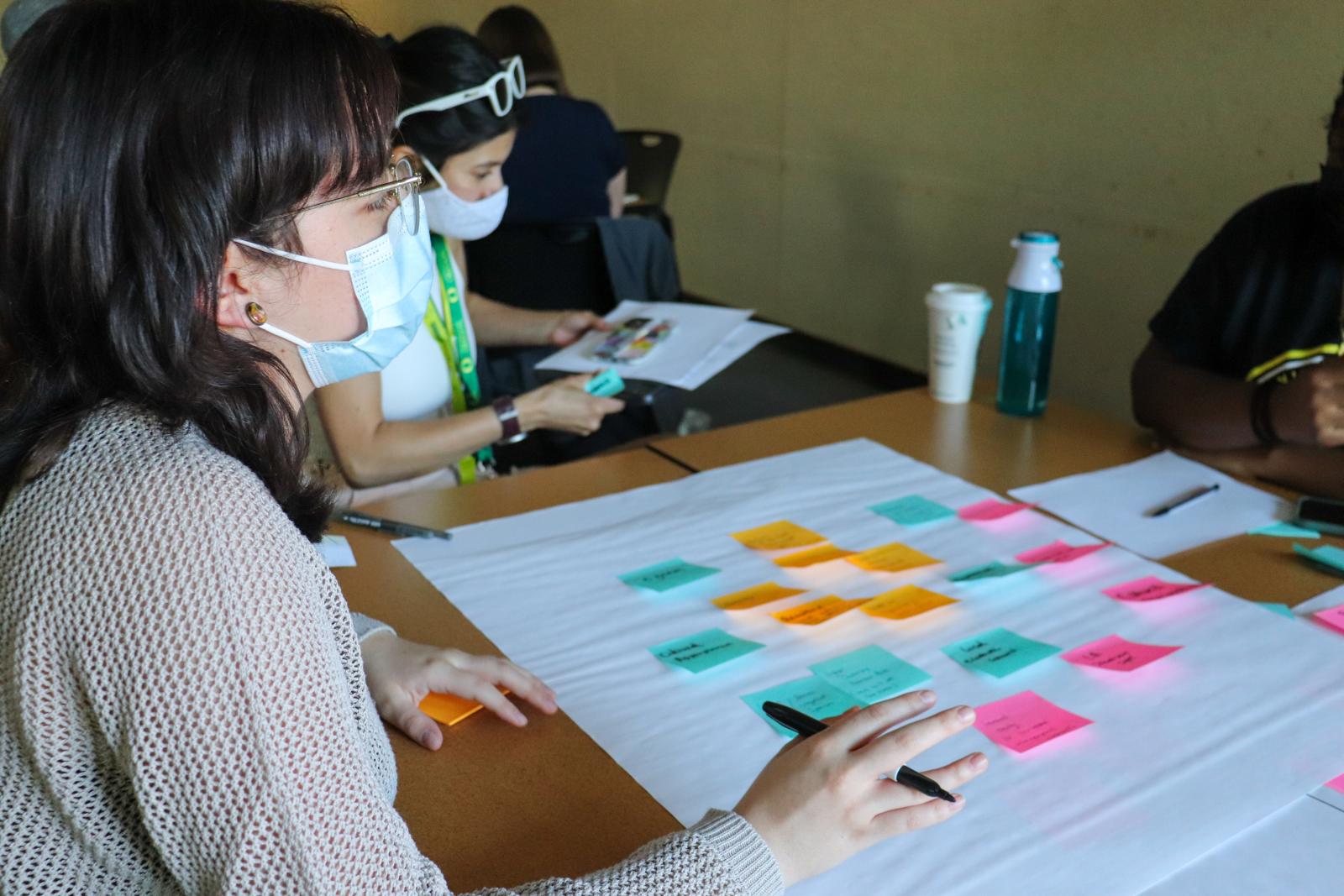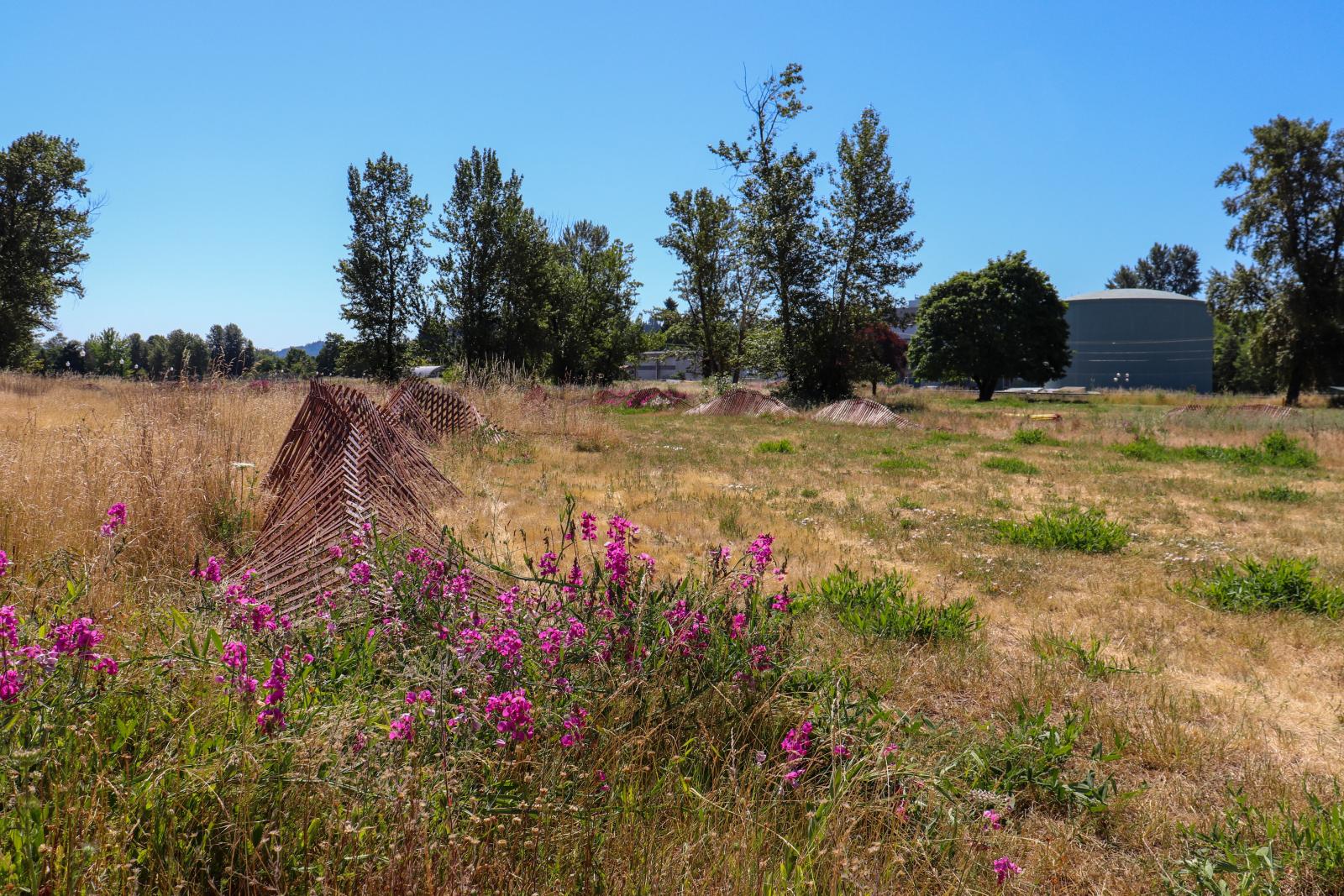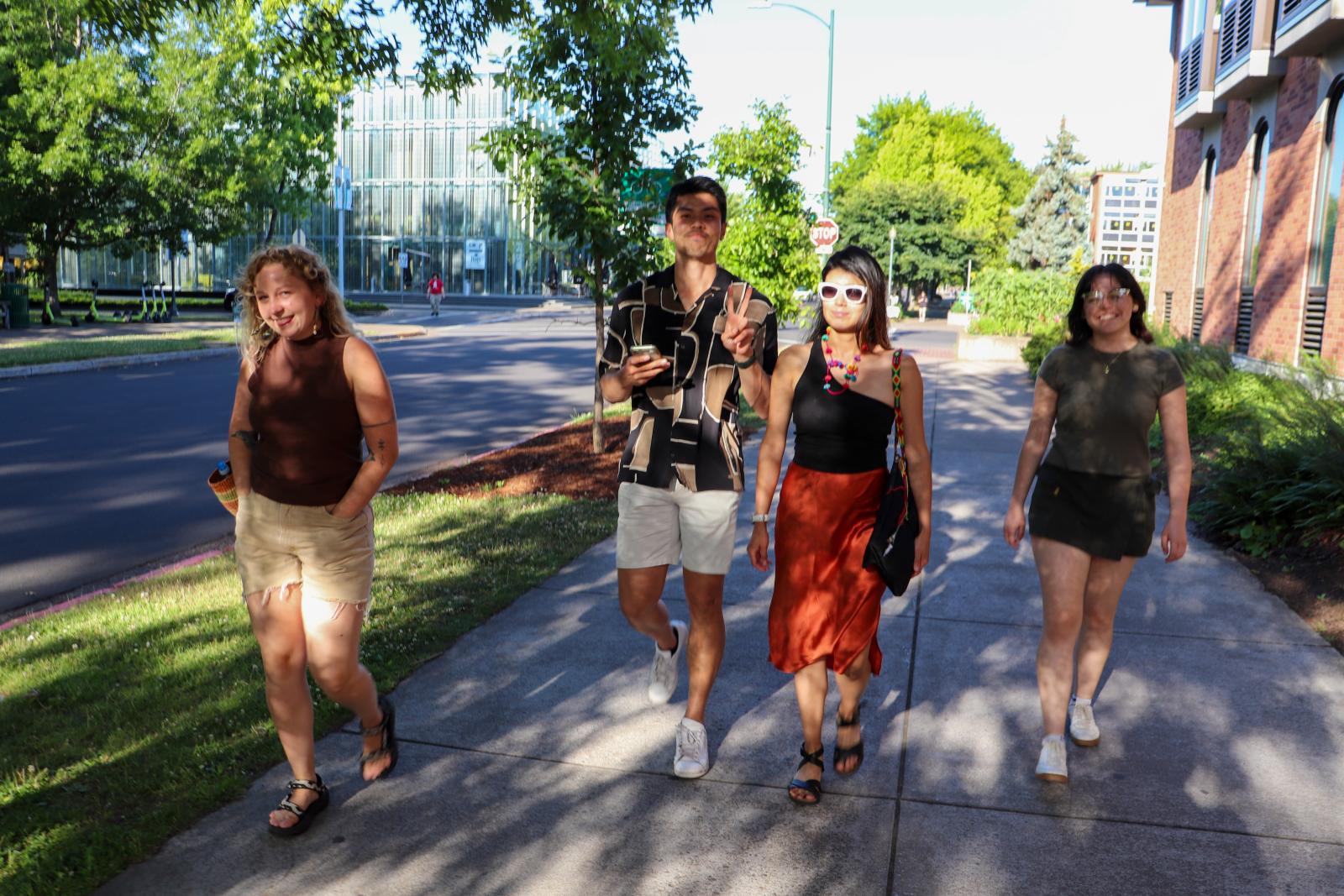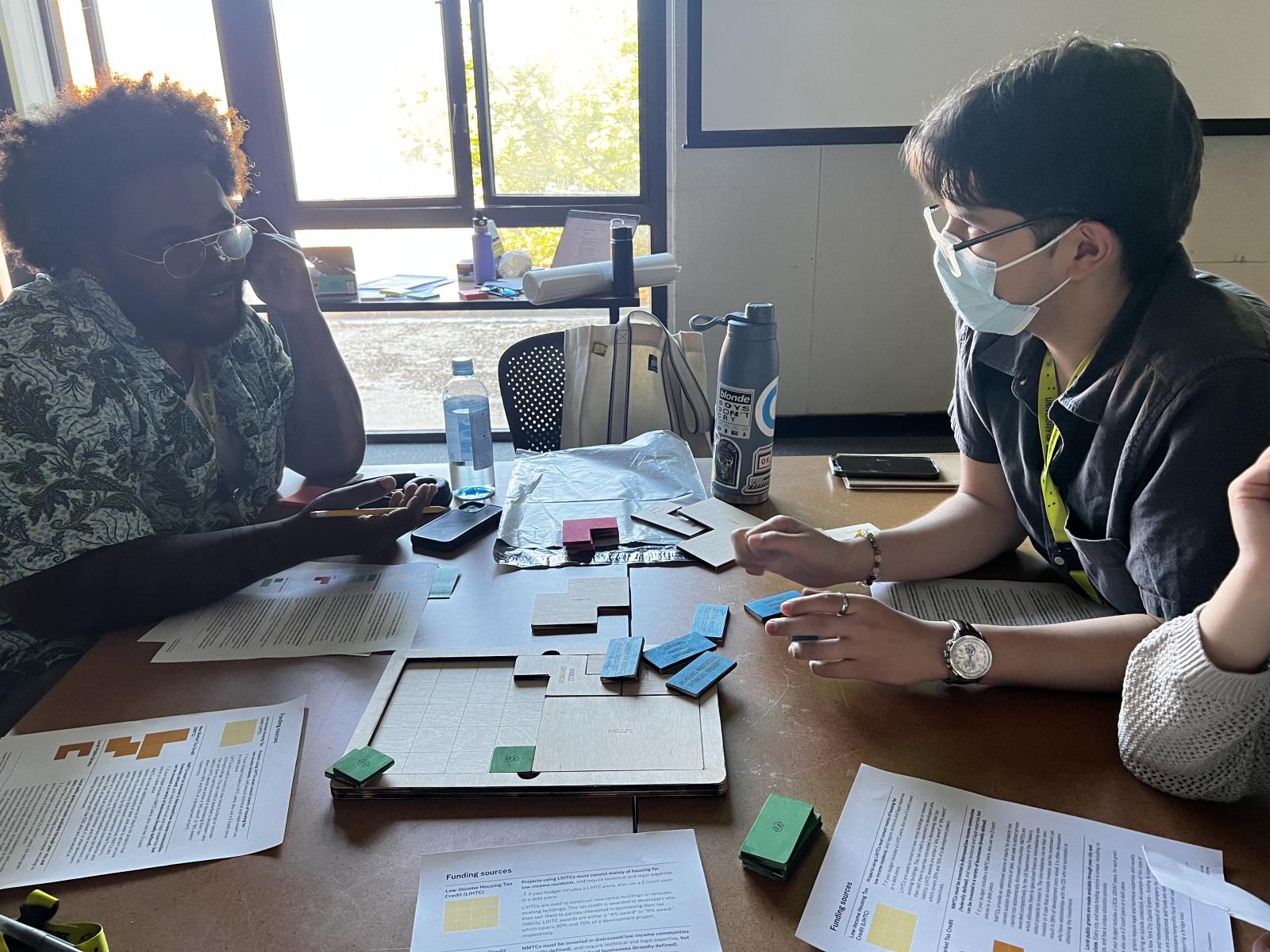2023 Design Futures Student Leadership Forum
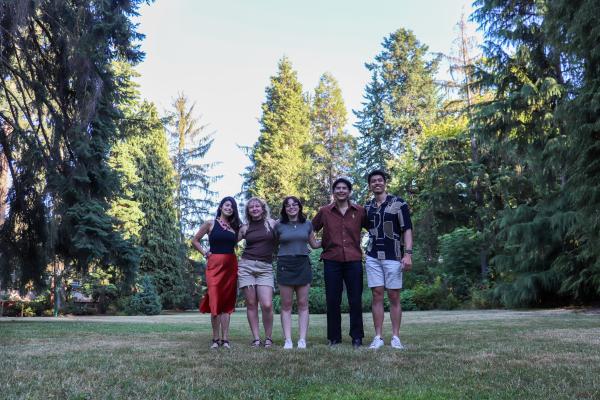
This summer, an interdisciplinary group of School of Architecture students attended the 10th annual Design Futures Student Leadership Forum. Since its inception in 2013, the multi-day leadership development program has brought students from around the country together, alongside practitioners and university faculty, for interactive workshops, presentations, and discussions about the power of community-engaged design as a tool for social equity and positive change.
The University of Texas at Austin School of Architecture has had students representing the school at Design Futures since its inception, and Assistant Director of Research Sarah Wu serves as one of the organization’s Advisory Board Members.
This year’s forum took place from June 26-30 at The University of Portland in Eugene, Oregon. Student attendees included Paula Cano (Master of Architecture), Catherine Gallagher (Master of Architecture), Daniel Guerra (Bachelor of Architecture), Lauren Guerra (Bachelor of Architecture), and Shawn Lee (Master of Science in Community & Regional Planning). We recently caught up with them to learn more about what they learned at the conference and what they hope to bring back to their work and the school.
- What was the most impactful workshop or part of the conference for you?
- What were some of your biggest insights or takeaways from the forum?
- What lessons would you like to bring back to your work and experience here at UTSOA?
- Anything else you would like to share about the experience?
WHAT WAS THE MOST IMPACTFUL PART OF THE CONFERENCE FOR YOU?
PAULA CANO: The INSIDER/OUTSIDER workshop evidenced the urgency of changing the narrative from “an equitable design” to an equal world, from a homogenized design to a fair one. During the workshop, groups worked on strategies to increase collaboration and influence better relationships between designers and groups of society often isolated by their age, abilities, gender, language, race, and any other circumstance in “disfavor.” Terminology is ever-changing, just like our cultural traditions, and by starting to question how we determine and interpret society, design will serve more as a tool than segregationally practice. The approach revealed that it is not necessary to establish a new paradigm to decentralize and achieve equity. Small actions, like examining who’s at the table and who is writing history, can lead architecture, urban planning, and design to focus on wider, more innovative, and creative scopes to start actively collaborating with marginalized communities.
CATHERINE GALLAGHER: The Racism Untaught workshop led by Terresa Moses and Lisa Elzey Mercer stood out to me. Not only did Terresa and Lisa create a space where people felt comfortable sharing their lived experiences, but the workshop also allowed for the tension of pushing beyond our comfort zones to discuss identity and oppression. How can we begin to address unjust institutions or behaviors if we have never had to have nuanced conversations about our positionality/ identity within oppressive systems or about taking positive action outside those systems? The workshop touched on so many things that were a common thread throughout Design Futures: constructed identities, understanding power structures/oppression, and dissecting problems in an anti-racist, action-oriented way.
DANIEL GUERRA: I would say, by far, the most meaningful workshop for me was Racism Untaught by Lisa Mercer and Terresa Moses, which explored topics of positionality, intersectionality, and identity. The exercises we conducted as part of the workshop aimed to help us recognize our positionality in society. Everyone should attempt to acknowledge the privileges they were born with, or the lack of, and understand how greatly these affect their lives. Intersectionality was a topic we addressed in the forum on multiple occasions, but we explored it more deeply in this workshop. The way they described intersectionality is like compounded identity: Having (or not having) an identity with others creates different and massive degrees of disparity in privilege.
LAUREN GUERRA: I enjoyed hearing so many different perspectives, not only on design issues but social and cultural dynamics, ideas of innovation, and so much more. The environment in every workshop was accepting and encouraged us to step out of our comfort zone and learn from each other, regardless of how much we knew about a specific issue. The most impactful workshop for me was From Awareness to Action: Integrating Trauma-Informed Engagement Strategies. In this session, employees from Kounkuey Design Initiative’s Los Angeles office described projects where they interacted with a local community to design solutions to increase the population’s quality of life. The efforts that they discussed allowed me to reimagine what intentional architecture can accomplish. By holding ourselves accountable as designers, we can work together with those a project will affect most and create amazing outcomes.
SHAWN LEE: The most impactful part of the conference for me was the local day tour that I went on, which took us to two housing projects in Eugene – Emerald Village and Opportunity Village. These are transitional housing sites for unhoused individuals managed by Square One Villages. Seeing first-hand the types of housing and environments in which unhoused people live was certainly impactful. It was also informational to hear directly from one of the residents at Emerald Village, who also happens to co-run the housing development, about her experience and thoughts about affordable housing issues in Eugene. Undoubtedly, the projects have helped support some of the unhoused population in Eugene and are a great first step. While visiting these sites, however, I couldn’t help but wonder if efforts to encourage supportive housing might be somewhat half-hearted. What struck me from the visit was that these sites were located far away from other residential areas, a distance from the main road where public transit services ran, and, most importantly, within an industrial district where trucks constantly drive by and factory buildings are their neighbors. It made me realize how difficult it is for cities to help the disadvantaged segment of the population while also dealing with NIMBYism.
WHAT WERE SOME OF YOUR BIGGEST INSIGHTS OR TAKEAWAYS FROM THE FORUM?
PAULA: Challenge Power. Dismantle Systems. Design a just World.
CATHERINE: I often find it hard to untangle the complicated web of equity when thinking about projects. What I appreciated about the forum was all the different strategies for identifying the stakeholders and power structures within projects, from power mapping to community-based system dynamic approaches. Understanding the systems of power that are in place (and our roles within them) allows us to advocate for shifts in power structures and resource allocations. For design specifically, a big takeaway for me was that for the outcome to be equitable, the process must also be equitable: from starting with an acknowledgment of the work communities have already done to who is at the table during the process and how important it is to imagine a timeline for long term change, but also to consider individuals’ daily experiences.
DANIEL: My biggest takeaway is the role designers play in scale, both in the present time and throughout human history. By this I mean the shifting mindset of what we envision the built environment to be and the small (yet extremely significant) role we play. If you feel frustrated and angered by how our community is structured around systems of oppression, try to reflect on the efforts and the thoughts of those in the past who fought to get to the point we are now. Just as it took generations for this system to establish itself, it will also take generations to dismantle it. We must continue this journey and carry the torch.
LAUREN: One of the biggest challenges I had before attending the workshop was finding ways to connect with the local community that a project pertains to, especially if it is one I haven’t lived in or by. Hearing from the speakers at the forum helped me realize that how to understand others is simply through conversation. We must not only listen but digest and recognize the needs of a community so that we can use design as a tool to implement change for years to come.
Overall, this forum made me more aware of marginalization strategies and increased my desire to combat them. I am more committed in my thought that we all have power as designers and, through intentional effort, we can learn how to employ it to create better living conditions for all we design with.
SHAWN: Often, I find that it is easy for me to assume that people belonging to a specific identity – race, gender, ability, etc. – would have similar experiences, and so, planning can be based on these broad categories. This forum made me more aware of the concept of intersectionality and that a person can hold multiple identities simultaneously. What this means for planning is that it is not enough to simply, for example, plan for the youth, the disabled, or for BIPOC populations in silo. So far, it seems like the planning field hasn’t been planning for a combination of identities. Maybe it is more resource-intensive, or maybe planners are less aware; Notwithstanding, the forum taught me that if we can plan with intersectionality in mind and for the most marginalized group, policies would end up benefitting people in most identity groups. Perhaps, then, planners should go one step further in their planning process to not only get a good understanding of their community’s identities but also the relationships between them.
WHAT LESSONS WOULD YOU LIKE TO BRING BACK TO YOUR WORK AND EXPERIENCE HERE AT UTSOA?
PAULA: One of the primary objectives of the Design Futures Forum was to bring the scholar community together in conversations about critical topics of diversity and inclusion to foster the normative expectation of competent communication and design. Although discussing our biases and wounds was hard, the forum showed that academia needs spaces to listen and reflect, spaces for healing.
I would like to bring to UTSOA the logic and principles of open discussions learned during the forum, from encouraging people to move out from their social comfort zone to share with other members from different backgrounds; to more formal spaces, like monthly lectures about a range of topics. We could hold these conversations over class hours, the lecture series, or happy hours to provide easy access for students, faculty, and staff to speak comfortably.
Architects and designers have a high capacity to visualize a better future, but we need to bridge our intentions with better communication and relationships. Encouraging critical thinking and open talking within the school would provide us with tools to understand different perspectives and realities so we can better design for the current world’s challenges and serve through design instead of imposition.
CATHERINE: I think moving forward, as an architecture student, I need to set aside time early in the design process to consider how my positionality impacts my proposal. Regardless of whether it’s a built project or a speculative studio project, I think it’s important to begin creating patterns of thought that I can utilize in practice to question and shape my design process. I also think our academic environment is a crucial place to address equity. As policies threaten Diversity, Equity, and Inclusion at the university, we, as students, must advocate for a culture of inclusivity and equity and push to see diversity in the types of discussions we can have, the seminars available to us, and the way funds are allocated.
DANIEL: The main takeaway for me is that communication between designers on a larger scale is extremely necessary, so we have launched a communication channel between Undergraduate Student Councils across multiple universities nationally. We think this collaboration is a necessary step: For the built environment to be more equitable, those learning how to design it should come from all backgrounds. Thus, making design/architecture education more equitable is a necessary step toward this; without the diversity of perspectives, we cannot make progress.
LAUREN: I think the most important thing is that we have conversations like the ones we had at Design Futures. I learned so much by sitting through these discussions that are often avoided by many in everyday life. It is our responsibility to hold ourselves accountable and discuss these topics so we are aware of the negative history that design has had in some contexts. Progress is made by discussion, and for us to understand each other’s struggles and experiences, both because of and beyond design, we must openly communicate with one another.
Lastly, I think the rules we set at the beginning of the conference created a healthy environment for all involved. Specifically, I appreciated “Feelings are as important as intellect.” I often discredit my thoughts because there is no direct evidence other than my opinion. Now I find it more important to pay attention to both my and others’ emotions, as they should have as much validity as proven ideas. By considering this as proof of experience, we can give more importance to voices that may not be as accounted for as they should be.
SHAWN: As a planning student, I tend to look at a lot of quantitative data provided online by governmental bodies. This data tends to be structured and designed to tell only one of many possible stories about the communities we plan for. The diversity of a community can be so much greater than what secondary data might suggest, so it will be important for me to learn how to build experience in first-hand engagement with the community so that my understanding of the community is not based solely on figures and online charts, but also on conversations and interactions. To successfully engage with a broad spectrum of people, we need more training and education on diversity, equity, and inclusion at school. To achieve this, I think it is crucial that, as a school, we continue to advocate for diversity and inclusivity in all aspects, such as faculty and student body makeup, coursework topics, funding allocation, etc.
ANYTHING ELSE YOU WOULD LIKE TO SHARE?
PAULA: A key factor for the forum's success was the unique location of the University of Oregon in Eugene. Located in The Willamette Valley, surrounded by the Cascades Mountain Range, the venue highlighted the role of nature in transforming a segregated city into a community’s long-held vision of a vibrant, active, and accessible place.
One of the most ambitious plans is the Riverfront. This area will ultimately be home to at least 75 affordable housing units and 500 to 1,000 market-rate units. The city's Urban Renewal Agency leads the redevelopment of a portion of riverfront property that will become Eugene’s Riverfront Neighborhood – directly connecting downtown and campus and bringing more opportunities and growth while preserving the landscape.
Although this project required enormous efforts, change, and activism can also come from small actions like the Design Futures Forum or even smaller ones like this opportunity to disseminate and celebrate this experience with the UTSOA community via media, events, and lectures.
CATHERINE: Design Futures was one of the most unique spaces I have been in. It was a true privilege to be in a space that was so vulnerable and genuine and to witness so much hope in addressing oppressive structures as designers. I enjoyed connecting with people from other institutions and also forging better connections within our UTSOA cohort.
DANIEL: Design Futures Forum was an informative, engaging, and insightful experience. The wide variety of workshops, the facilitators, and, most importantly, the students all created an environment of courage and safety. I would highly recommend that anyone interested in this program apply and do their best to make it.
LAUREN: I highly recommend it to anyone that can get involved with this forum! It was an incredible learning experience that isn’t replicated in many other organizations. Every day of this conference was an opportunity to grow in ways that aren’t always accessible in our everyday lives. I believe that we should all be proficient in both the positive and negative history of design so we may hold ourselves accountable for the implications we may cause through our efforts.
SHAWN: Design Futures gave me a unique opportunity to learn about themes I wasn’t conversant with within a safe space. I had an enriching and meaningful time listening to the exchanges on sometimes controversial topics and engaging with students from other institutions. Most importantly, I had an amazing time getting to know my fellow UTSOA students! Overall, I found the personal connections I made the most precious, and I feel very fortunate to have had this opportunity.
STUDENTS:
Paula Cano (Master of Architecture)
Catherine Gallagher (Master of Architecture)
Daniel Guerra (Bachelor of Architecture)
Lauren Guerra (Bachelor of Architecture)
Shawn Lee (Master of Science in Community and Regional Planning)
